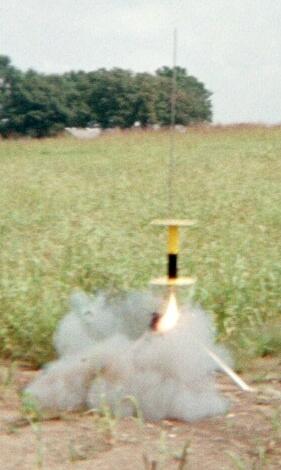Scratch Big Head Pete's Spool Rocket Original Design / Scratch Built
Scratch - Big Head Pete's Spool Rocket {Scratch}
Contributed by Pete Lilja
| Manufacturer: | Scratch |

(Contributed - by Pete Lilja - 11/15/02)
 Brief:
Brief:
15" Spool Rocket with 29 mm MMT and parachute recovery.
Construction:
3/16" Aircraft Plywood Disks - 12" diameter
2.6" Body Tube
2.6" Coupler Tube
Parachute
10' TN Shock Cord
Eye Bolts
Quick Links
Motor Retainer
This is a spool rocket was built with standard rocket parts and recovery. The body tube separates at ejection for parachute recovery.
Top and bottom plates are made from aircraft plywood. A twelve inch circle was drawn and cut out on a band saw then match sanded to round. Circle cutter was used to 'score' the top plate so that the body tube was slightly recessed to give more bite to the epoxy fillet.
The eye bolt used for shock cord attachment passes through the top plate and an acorn nut was used on the top outside for finish detail. The bottom plate has a hole that the body tube passes through. I used T-nuts, screws and clips for motor retention as on other rockets. Launch lugs are simply a 3/8" clearance hole drilled into both plates and aligned when placing on launch pad/rod.
Flight:
Rocket prep is the same as any other rocket. Wadding placed on top of motor as
usual.
I have flown this rocket 9 times on various motors. It crashed on a G35-4 and F20-4. On a G80-4 the parachute barely had time to open before landing. The best flights were on H128 with a short delay and typically an F50-4 works very well. The F50 is the perfect SU motor for this rocket and an H97 reload would make for a great flight.
Summary:
This rocket needs a short delay as its coast time is almost non-existent due to
its high drag. It basically boosts, then stops and begins to fall. Use as short
a delay as possible.
It is a fun flyer and is amazing to watch. Seeing the rocket's entire flight profile with the unaided eye is different from most rocket flights. It is not too often you can see the boost, apogee, ejection and then the parachute fill. The maximum altitude achieved is not more than 100 to 125 feet.
Other:
This rocket was an experiment is using HPR building techniques/design for a
spool. I fiberglassed the body tube because I am unsure of the high drag forces
effect on the body tube. I do not know if an un-glassed tube would survive a
launch undamaged. This is definitely a small field flyer since the altitude
achieved is so low. I would have rather built it with a 38mm MMT for a greater
range of motor selection. RockSim flight simulations are not accurate
presumably due to non-standard design.
 |
 |